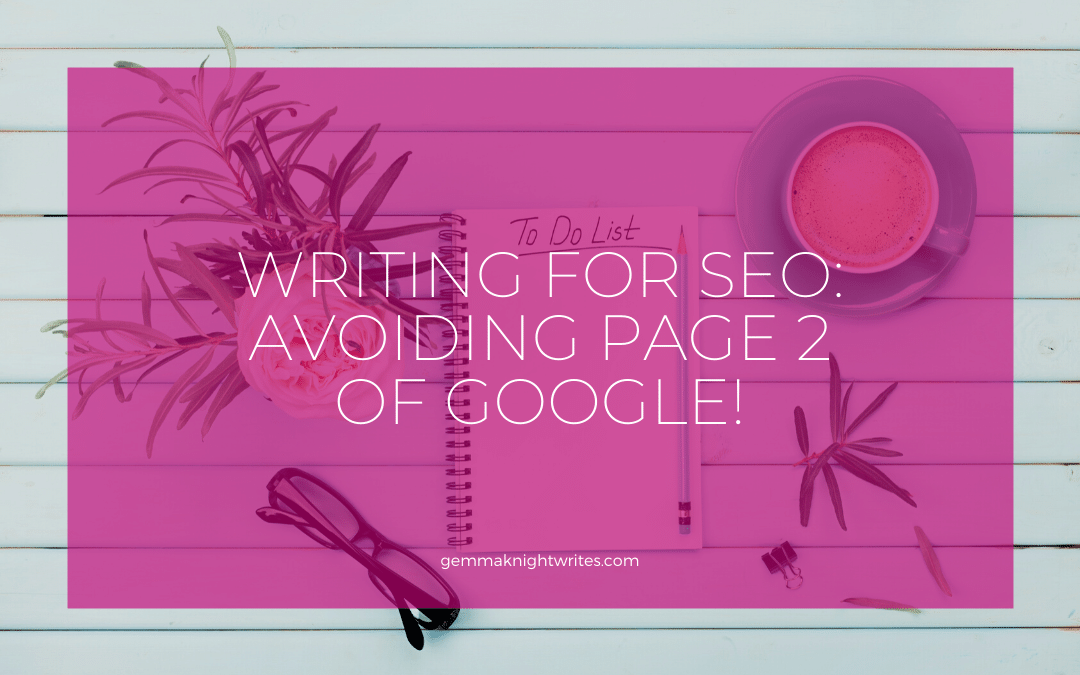When was the last time you clicked to see Page 2 of Google’s search results?
Was it a time when dinosaurs walked the earth?
Or maybe clicking to Page 2 is just like skipping your morning coffee… it’s something you just don’t do!
We all know that Page 1 is the ultimate SEO goal.
Anything less than that greatly reduces the chances of your business being found online.
So, how do you go about writing for SEO?
Part of an effective blogging marketing strategy is using Search Engine Optimisation to your advantage.
Content and SEO go hand in hand. Without the right SEO tactics, you will find your content slipping down the search engine results page.
Anything beyond page 1 on Google means that you may as well be confined to the scrapheap. But when it comes to creating SEO-rich content, there are some tactics that your business can utilise.
Here’s how you can nail the practice of writing for SEO:
Writing for SEO: Avoiding Page 2 On Google!
Create Keyword-Rich Phrases
The term ‘keyword-rich phrases’ is just a fancy way of saying sentences that include your keyword/s in a clear and logical way. The keywords should read naturally in the sentence and not make the language seem stilted or weird.
By using keyword-rich phrases in your headlines and throughout the content it tells your readers what the blog is about, while also sending the right signals to the search engine.
You have to be aware that too many keywords, also known as keyword stuffing, can result in search engine penalties. That is why some businesses choose to outsource this aspect to an SEO company.
It’s always best to write for your readers before writing for SEO. This helps you to stick to a more natural feel for the bulk of the post.
Write For Your Audience
One of the most important, if not THE most important aspects of Search Engine Optimisation, is to create content for your target audience.
When you create content that appeals to the interests of your key demographic and answers their questions, it will make the SEO process easier. Google rankings take a lot of things into account, some of the key aspects are people actually visiting your site and the amount of time a visitor spends on a page.
If the content has no relevance to your business or is of no worth to your audience, then they will click away quickly. Obviously, this does not look good to Google’s search bots. They will hesitate to suggest your content if too many people speedily ‘bounce’ away from the page.
So, when you are publishing content for your business, you have always got to consider your audience first. Don’t overthink it.
Short, Sharp Headlines
You don’t have long to make a big impression. An effective headline that is clear and makes the use of your keywords will appeal to the desired audience, but will also show up on the search engine results.
When you are writing for search engine optimisation, the title should elicit an emotional response. That encourages an individual to click on it.
As well as considering an emotional response, you want your title to fit on the page. If it is too long, then potential site visitors will not be able to read the whole thing. This could discourage them from clicking through.
You should aim for a title length of fewer than 60 characters to be safe. However, you can also find numerous title length checkers online to see if you are coming in around the desired length.
Imagery!
Words are great, but people are also visual beings. Blogs require images or even embedded video content to capture their attention and make a bigger impression.
It is also another opportunity to tick an SEO box. You can add an Alt tag to your images which allows the Google search bots to ‘read’ your image. So, when you incorporate visual materials in your posts, they are more likely to get picked up by the search engine.
Promote With Social Media
Blogs are great, but if people don’t know they are there, they can’t read them! So, drumming up web traffic should be part of your publishing process. More clicks on your links give your site greater authority in the eyes of the search engine bots. More authority means a greater chance of appearing in the Page 1 results.
The easiest way to get your content out there is to promote it through social media platforms and your email database. This helps the webpage to get plenty of traffic in the first instance. Secondly, it helps Google to register it as an authority piece and allows it to be shown in search results.
This process helps your pieces of content to have a very long shelf life as they will continue to appear in search results again and again. Sometimes, popular pieces can still get traffic years after their publication date, especially if you continue to update the content to keep it relevant.
Search Engine Optimisation is a constantly evolving entity. In order to guarantee your business makes the right impact, you have to tailor your content in certain ways. That means making sure you are writing for SEO.
Remember, while “content is king,” that content is useless if no one sees it! That’s why it is important to understand how you can make your amazing piece of content go further.
Loved these tips? Then enter your details below and you can get more great ideas like this delivered to your inbox every week!

